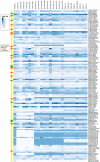Pharmacogenomic landscape of Indian population using whole genomes
- PMID: 35338580
- PMCID: PMC9010271
- DOI: 10.1111/cts.13153
Pharmacogenomic landscape of Indian population using whole genomes
Abstract
Ethnic differences in pharmacogenomic (PGx) variants have been well documented in literature and could significantly impact variability in response and adverse events to therapeutics. India is a large country with diverse ethnic populations of distinct genetic architecture. India's national genome sequencing initiative (IndiGen) provides a unique opportunity to explore the landscape of PGx variants using population-scale whole genome sequences. We have analyzed the IndiGen variation dataset (N = 1029 genomes) along with global population scale databases to map the most prevalent clinically actionable and potentially deleterious PGx variants among Indians. Differential frequencies for the known and novel variants were studied and interaction of the disrupted PGx genes affecting drug responses were analyzed by performing a pathway analysis. We have highlighted significant differences in the allele frequencies of clinically actionable PGx variants in Indians when compared to the global populations. We identified 134 mostly common (allele frequency [AF] > 0.1) potentially deleterious PGx variants that could alter or inhibit the function of 102 pharmacogenes in Indians. We also estimate that on, an average, each Indian individual carried eight PGx variants (single nucleotide variants) that have a direct impact on the choice of treatment or drug dosing. We have also highlighted clinically actionable PGx variants and genes for which preemptive genotyping is most recommended for the Indian population. The study has put forward the most comprehensive PGx landscape of the Indian population from whole genomes that could enable optimized drug selection and genotype-guided prescriptions for improved therapeutic outcomes and minimizing adverse events.
© 2022 The Authors. Clinical and Translational Science published by Wiley Periodicals LLC on behalf of the American Society for Clinical Pharmacology and Therapeutics.
Conflict of interest statement
The authors declared no competing interests for this work.
Figures



References
-
- Roden DM, George AL Jr. The genetic basis of variability in drug responses. Nat Rev Drug Discov. 2002;1:37‐44. - PubMed
-
- Center for Drug Evaluation & Research . Table of pharmacogenomic biomarkers. https://www.fda.gov/drugs/science‐and‐research‐drugs/table‐pharmacogenom... (2020).
-
- Clinical Pharmacogenetics Implementation Consortium (CPIC) Guidelines. https://cpicpgx.org/guidelines.
MeSH terms
LinkOut - more resources
Full Text Sources

